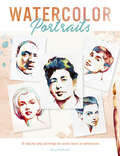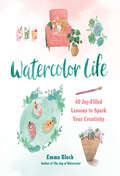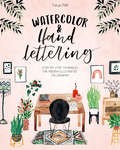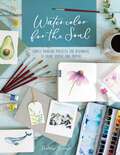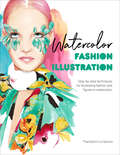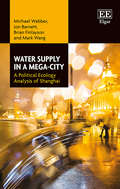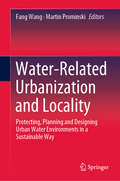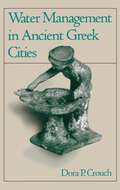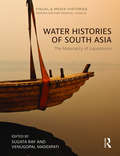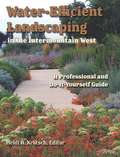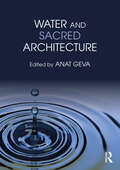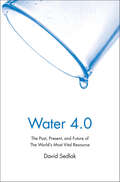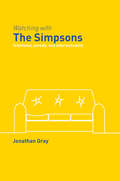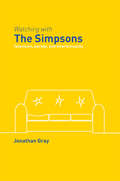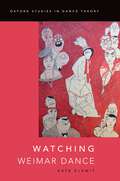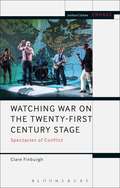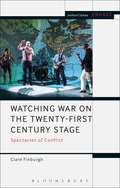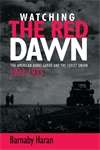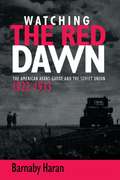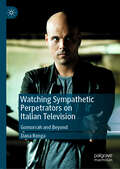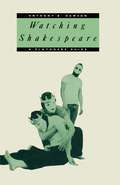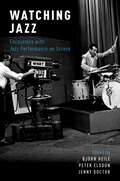- Table View
- List View
Watercolor Life: 40 Joy-Filled Lessons to Spark Your Creativity
by Emma BlockDiscover the joy and versatility of watercolors with forty gorgeously illustrated lessons for any skill level. Watercolors are beautiful in their simplicity: a basic palette of paints, a few brushes, and nice thick paper will do the job. The medium is also beautiful, though, in its depths and complexities. Here, watercolor artist and instructor Emma Block focuses on techniques, materials, and lessons to help you explore new watercolor techniques, build creative confidence, and discover your unique style of painting. She'll show you—with clear, step-by-step instructions—how to paint everything from people, plants, and animals perfect for framing to patterns and washes perfect for stationery and housewares. The forty lessons cover useful topics like:Quality materials and how they can elevate your craftColor theory 101 to help you confidently create artwork all your ownA techniques glossary full of exciting new skills to learnTips for finding creative inspiration in your everyday lifeNote: For complete instructions on mixing hair colors (page 192), visit https://www.runningpress.com/articles/errata-note-watercolor-life/.
Watercolor & Hand Lettering: Step-by-step techniques for modern illustrated calligraphy
by Tanja PöltlLearn how to combine delicate watercolor illustrations with expressive hand lettering to create beautiful art and gifts. Self-taught artist Tanja Pöltl shares the tips, tricks and know-how she's learned on her creative journey so that you can fast-track your skills. Discover the materials you'll need in terms of watercolor paints, brushes, paper and pens, then get started with Tanja's exercises to learn the basic techniques of hand lettering and watercolor painting. In the Hand Lettering Know-How section you will start with some warm up exercises and practice letters, before learning faux calligraphy, bounce lettering, joining letters and more. In the Watercolor Know-How section you will learn how to handle the brush, and gain color knowledge as well as an understanding of tonal values, transparency and opacity, and learn how to create your own unique color palette. 20 amazing step-by-step painting and lettering projects then help you put your skills in action with ideas for a myriad of different applications. Create a moodboard, inspirational cards, seasonal gift boxes, a botanical table runner, a plant journal, floral greetings cards, fruity jar labels, posters, hoop art, party stationery, a birth poster, milestone cards, a height chart, recipe cards, an illustrated ABC, box frames, 3D flowers, and more – all beautifully illustrated in a modern yet timeless style. These inspiring projects are so varied and interesting, and will undoubtedly spark ideas for all sorts of other ways you can use watercolor and hand lettering together to create beautiful yet easy art. Even if you are a total beginner, this book will kickstart your creative journey with watercolor and hand lettering, showing you the techniques and giving you fun projects to try them out on. This accessible guide to easy watercolour and hand lettering techniques will teach you everything you need to make art that makes you happy! Self-taught and full of enthusiasm for experimentation artist Tanja Pöltl is your teacher and guide. She's taught thousands of beginners to find their creative voice through her workshops and classes, and can't wait to help you on your journey into the wonderful world of watercolor and hand lettering.
Watercolor For The Soul: Simple painting projects for beginners, to calm, soothe and inspire
by Sharone StevensLearn how to use watercolor to soothe your soul with this beginner’s guide to painting for relaxation. This fresh approach looks first at the process of painting as a means to de-stress and unwind. Many people love the idea of painting but hold themselves back from starting because they are worried about not being good enough or not feeling as though as are creative. In this guide for the absolute beginner, artist and teacher Sharone Stevens shows you that watercolor can be accessible to everyone and that just painting very simple lines, patterns and shapes in calming colors, concentrating on each brush stroke, can have a powerful meditative effect, while at the same time allowing you to create beautiful art you can be proud of. She also encourages you to connect more with the world around you, finding inspiration in your every-day life and discovering the beautiful textures found in nature, from tree trunks to fruit and butterflies! The aim of the techniques and projects in this book is to create art that relaxes both the artist and the viewer of the finished piece. Projects range from simple gift tags, bookmarks, cards and small wall pieces to larger art pieces that you never thought possible – all done with a focus on relaxation – which is so important in today’s fast-paced, increasingly digital world. Learn how to mix a calming color palette, try simple painting exercises to get into a relaxed flow, and create beautiful artworks that will lift the spirits both during the painting process and beyond, as finished pieces of art. Author Sharone Stevens is an established art teacher and talented artist who is passionate about using art for relaxation and encouraging others to build a regular creative practice. Her gentle lessons and nurturing reassurance will guide even total beginners through the process of making soothing, soulful modern watercolor art.
Watercolor Fashion Illustration: Step-by-step techniques for illustrating fashion and figures in watercolors
by Francesco Lo IaconoLearn to paint outstanding fashion watercolors with expert guidance from a leading fashion illustrator. Watercolor is a wonderful medium for figure and fashion as it creates loose, impressionistic results that capture the essence of a look without getting too bogged down in the details. In this complete course, professional fashion illustrator Francesco Lo Iacono shows you how to master creating delicate, beautiful fashion illustrations. The book begins with the best tools and materials, from paints and brushes to pencils, paper and more. You'll then explore simple watercolor techniques such as washes, wet-on-wet, wet-on-dry, and using the white of the paper. Francesco then goes on to teach you about lighting and shading, which can have a dramatic effect on your work. And finally in the front section, you'll learn about colour, how to create palettes, how to mix colours and achieving a range of skin tones. Once you've covered these fundamentals, Francesco explores the key elements of illustrating fashion, with guidance on how to approach both male and female faces, a wide variety of hair types and styles, different male and female poses, and how to draw and paint garments, reflecting tailoring, drapery, volume, texture and patterns. Twenty step-by-step projects then take these building blocks and show you how to use them to create beautiful fashion watercolors, starting with easier subjects and building in complexity as your confidence grows. You'll begin by painting handbags and shoes without models before starting to introduce figures. The range of subjects included covers all angles, from full figures front on and in profile to close-up make-up and beauty illustrations. You'll also learn how to create dynamic compositions for editorial fashion illustration. Finally, Francesco covers the best ways to digitize and retouch your work, how to incorporate other media alongside your watercolors, how to work live at fashion events and how to take everything you've learned to develop your own personal style of fashion illustration. Francesco's clients include fashion brands Dior, Gucci, and Louis Vuitton – and with this book you'll have all the tools you need to become an A-list fashion illustrator too.
Water Supply in a Mega-City: A Political Ecology Analysis of Shanghai
by Michael Webber Jon Barnett Brian Finlayson Mark WangWith the increasing threat of depleted and contaminated water supplies around the world, this book provides a timely and much needed analysis of how cities should manage this precious resource. Integrating the environmental, economic, political and socio-cultural dimensions of water management, the authors outline how future mega-city systems can maintain a high quality of life for its residents. With the rapidly evolving and wealthy Shanghai as the key example, the paradox between the wealth of a city and the quality of its water is uncovered. With a multidisciplinary and multi-scale analysis, the supply of water to cities is discussed in the context of rivers, households, corporations, government and infrastructures. Chapters include the influence of household water use, the political economy of water management, the sources and management of pollution, catchment dynamics, and a Bayesian model for calculating future demand. This comprehensive study shows how essential water management will be to new, developing and expanding cities in the foreseeable future. Water Supply in a Mega-City will be of interest to researchers from across social, natural and engineering sciences interested in the theoretical and practical management of this essential resource in large cities, as well as those interested in the way cities respond to changing environmental conditions.
Water-Related Urbanization and Locality: Protecting, Planning and Designing Urban Water Environments in a Sustainable Way
by Fang Wang Martin ProminskiThis book discusses the protection, planning, and design of sustainable urban water environments. Against the backdrop of environmental changes, it addresses issues of water resource protection and sustainable development in China and Germany at different stages of urbanization, as well as relevant strategies and lessons learned. It focuses on three topics: balance between water environment protection and utilization in the urbanization process; sustainable use of water resources in the urbanization process; and water-related planning and design strategies in urbanization and local cultural development processes. In the context of water resources, China and Germany can learn from each other’s experiences and can support one another in the fields of urbanization and locality. As such, the book brings together Chinese and Germans scientists from various disciplines, such as planning, geography, landscape, architecture, tourism, ecology, hydraulic engineering and history to provide a multicultural and multidisciplinary perspective on the topic and examine the challenges and opportunities as well as the planning and design strategies to achieve sustainable, water-related urban spaces. By combining theoretical and practical approaches, it appeals to academics and practitioners around the globe.
Water Management in Ancient Greek Cities
by Dora P. CrouchFocusing on the Mediterranean area where water management is crucial, this pioneering study is the first to show how the supply, distribution, and drainage of water contributed to the urbanization of ancient cities. Drawing from classical archaeology, the theory and history of urbanization, geology, and hydraulic engineering, Crouch examines water-system elements, including springs, fountains, wells, channels and drains, latrines, laundry, and dishwashing, as they relate to each other and to the physical, historical, and social bases of ancient Greek cities. Studying numerous sites including Pompeii, Pergamon, Athens, Samos, Delphi, and Corinth, she concludes that increased knowledge and skill in management of water contributed directly to the urbanization of the ancient Greek world. Illustrated with excellent photographs and line drawings, the discussions of supply, distribution, and drainage of water are organized topically, rather than chronologically or by site, offering an excellent example of the interdisciplinary approach. Crouch's study raises stimulating questions for further research, indicates entirely new directions for established academic disciplines, and suggests useful procedures for modern cities facing problems of water supply and management.
Water Histories of South Asia: The Materiality of Liquescence (Visual and Media Histories)
by Sugata Ray Venugopal MaddipatiThis book surveys the intersections between water systems and the phenomenology of visual cultures in early modern, colonial and contemporary South Asia. Bringing together contributions by eminent artists, architects, curators and scholars who explore the connections between the environmental and the cultural, the volume situates water in an expansive relational domain. It covers disciplines as diverse as literary studies, environmental humanities, sustainable design, urban planning and media studies. The chapters explore the ways in which material cultures of water generate technological and aesthetic acts of envisioning geographies, and make an intervention within political, social and cultural discourses. A critical interjection in the sociologies of water in the subcontinent, the book brings art history into conversation with current debates on climate change by examining water’s artistic, architectural, engineering, religious, scientific and environmental facets from the 16th century to the present. This is one of the first books on South Asia’s art, architecture and visual history to interweave the ecological with the aesthetic under the emerging field of eco art history. The volume will be of interest to scholars and general readers of art history, Islamic studies, South Asian studies, urban studies, architecture, geography, history and environmental studies. It will also appeal to activists, curators, art critics and those interested in water management.
Water Histories of South Asia: The Materiality of Liquescence (Visual and Media Histories)
by Sugata Ray Venugopal MaddipatiThis book surveys the intersections between water systems and the phenomenology of visual cultures in early modern, colonial and contemporary South Asia. Bringing together contributions by eminent artists, architects, curators and scholars who explore the connections between the environmental and the cultural, the volume situates water in an expansive relational domain. It covers disciplines as diverse as literary studies, environmental humanities, sustainable design, urban planning and media studies. The chapters explore the ways in which material cultures of water generate technological and aesthetic acts of envisioning geographies, and make an intervention within political, social and cultural discourses. A critical interjection in the sociologies of water in the subcontinent, the book brings art history into conversation with current debates on climate change by examining water’s artistic, architectural, engineering, religious, scientific and environmental facets from the 16th century to the present. This is one of the first books on South Asia’s art, architecture and visual history to interweave the ecological with the aesthetic under the emerging field of eco art history. The volume will be of interest to scholars and general readers of art history, Islamic studies, South Asian studies, urban studies, architecture, geography, history and environmental studies. It will also appeal to activists, curators, art critics and those interested in water management.
Water-Efficient Landscaping in the Intermountain West: A Professional and Do-It-Yourself Guide
by Heidi A. Kratsch Heidi KratschThis working manual provides complete information on the technical aspects of designing, building, and maintaining waterwise landscapes in the Mountain West. Written particularly for professionals, including landscape designers, architects, contractors, and maintenance and irrigation specialists, it has an attractive, well-illustrated, user-friendly format that will make it useful as well to DIY homeowners and to educators, plant retailers, extension agents, and many others. The manual is organized according to landscape principles that are adapted to the climate of the intermountain region. Beginning with planning and design, the topical principles proceed through soil preparation, appropriate plant selection, practicalities of turfgrass, use of mulch, and irrigation planning, winding up with landscape maintenance. Designed for onsite, handy use, the book is illustrated with color images of landscapes, plants, and materials. Tables, charts, diagrams, landscape plans, plant lists, checklists, and other graphic resources are scattered throughout the manual, which is written in an accessible but information-rich style. Water-Efficient Landscaping in the Intermountain West answers, more comprehensively than any other single book, the need for professional information that addresses both growing awareness of the necessity for water conservation and the desire for beautiful, healthy yards and properties.
Water and Sacred Architecture
by Anat GevaThis edited book examines architectural representations that tie water, as a physical and symbolic property, with the sacred. The discussion centers on two levels of this relationship: how water influenced the sacredness of buildings across history and different religions; and how sacred architecture expressed the spiritual meaning of water. The volume deliberately offers original material on various unique contextual and design aspects of water and sacred architecture, rather than an attempt to produce a historic chronological analysis on the topic or focusing on a specific geographical region. As such, this unique volume adds a new dimension to the study of sacred architecture. The book’s chapters are compiled by a stellar group of scholars and practitioners from the US, Canada, Europe, Asia, and Africa. It addresses major aspects of water in religious buildings, such as, rituals, pilgrimage, water as a cultural material and place-making, hydro systems, modern practices, environmental considerations, the contribution of water to transforming secular into sacred, and future digital/cyber context of water and sacredness. All chapters are based on original archival studies, historical documents, and field visits to the sites and buildings. These examinations show water as an expression of architectural design, its materiality, and its spiritual values. The book will be of interest to architects, historians, environmentalists, archaeologists, religious scholars, and preservationists.
Water and Sacred Architecture
by Anat GevaThis edited book examines architectural representations that tie water, as a physical and symbolic property, with the sacred. The discussion centers on two levels of this relationship: how water influenced the sacredness of buildings across history and different religions; and how sacred architecture expressed the spiritual meaning of water. The volume deliberately offers original material on various unique contextual and design aspects of water and sacred architecture, rather than an attempt to produce a historic chronological analysis on the topic or focusing on a specific geographical region. As such, this unique volume adds a new dimension to the study of sacred architecture. The book’s chapters are compiled by a stellar group of scholars and practitioners from the US, Canada, Europe, Asia, and Africa. It addresses major aspects of water in religious buildings, such as, rituals, pilgrimage, water as a cultural material and place-making, hydro systems, modern practices, environmental considerations, the contribution of water to transforming secular into sacred, and future digital/cyber context of water and sacredness. All chapters are based on original archival studies, historical documents, and field visits to the sites and buildings. These examinations show water as an expression of architectural design, its materiality, and its spiritual values. The book will be of interest to architects, historians, environmentalists, archaeologists, religious scholars, and preservationists.
Water 4.0: The Past, Present, and Future of the World's Most Vital Resource
by David SedlakTurn on the faucet, and water pours out. Pull out the drain plug, and the dirty water disappears. Most of us give little thought to the hidden systems that bring us water and take it away when we’re done with it. But these underappreciated marvels of engineering face an array of challenges that cannot be solved without a fundamental change to our relationship with water, David Sedlak explains in this enlightening book. To make informed decisions about the future, we need to understand the three revolutions in urban water systems that have occurred over the past 2,500 years and the technologies that will remake the system. The author starts by describing Water 1.0, the early Roman aqueducts, fountains, and sewers that made dense urban living feasible. He then details the development of drinking water and sewage treatment systems—the second and third revolutions in urban water. He offers an insider’s look at current systems that rely on reservoirs, underground pipe networks, treatment plants, and storm sewers to provide water that is safe to drink, before addressing how these water systems will have to be reinvented. For everyone who cares about reliable, clean, abundant water, this book is essential reading.
Watching You, Watching Me (Back-2-Back #2)
by Chloe RaybanThere are two sides to every story and this new series, BACK-2-BACK, is designed to attract both boys and girls. Teenagers will love to read what she really thinks about him and what he really thinks about her!
Watching with The Simpsons: Television, Parody, and Intertextuality (Comedia)
by Jonathan GrayUsing our favourite Springfield family as a case study, Watching with The Simpsons examines the textual and social role of parody in offering critical commentary on other television programs and genres. Jonathan Gray brings together textual theory, discussions of television and the public sphere, and ideas of parody and comedy. Including primary audience research, it focuses on how The Simpsons has been able to talk back to three of television’s key genres - the sitcom, adverts and the news - and on how it holds the potential to short-circuit these genre’s meanings, power, and effects by provoking reinterpretations and offering more media literate recontextualizations. Examining television and media studies theory, the text of The Simpsons, and the show’s audience, Gray attempts to fully situate the show’s parody and humour within the lived realities of its audiences. In doing so, he further explores the possibilities for popular entertainment television to discuss issues of political and social importance. A must read for any student of media studies.
Watching with The Simpsons: Television, Parody, and Intertextuality (Comedia)
by Jonathan GrayUsing our favourite Springfield family as a case study, Watching with The Simpsons examines the textual and social role of parody in offering critical commentary on other television programs and genres. Jonathan Gray brings together textual theory, discussions of television and the public sphere, and ideas of parody and comedy. Including primary audience research, it focuses on how The Simpsons has been able to talk back to three of television’s key genres - the sitcom, adverts and the news - and on how it holds the potential to short-circuit these genre’s meanings, power, and effects by provoking reinterpretations and offering more media literate recontextualizations. Examining television and media studies theory, the text of The Simpsons, and the show’s audience, Gray attempts to fully situate the show’s parody and humour within the lived realities of its audiences. In doing so, he further explores the possibilities for popular entertainment television to discuss issues of political and social importance. A must read for any student of media studies.
Watching Weimar Dance (Oxford Studies in Dance Theory)
by Kate ElswitWatching Weimar Dance asks what audiences saw on stages from cabaret and revue to concert dance and experimental theatre in the turbulent moment of the Weimar Republic. Spectator reports that performers died or became half-machine archive not only the physicality of past performance, but also the ways audiences used the temporary world of the theatre to negotiate pressing social issues, from female visibility within commodity culture to human functioning in an era of increasing technologization. Archives of watching a range of performance artists, including Oskar Schlemmer, Valeska Gert, Kurt Jooss, Mary Wigman, Bertolt Brecht, Anita Berber, and the Tiller Girl troupes also revise and complicate our understanding of Ausdruckstanz as the representative dance of this moment in Germany. They further reveal how such practices came to be imbued with different significance in the postwar era as well as in transnational context. By bringing insights from theatre, dance, and performance studies to German cultural studies, and vice versa, Watching Weimar Dance develops a culturally-situated model of spectatorship that not only offers a new narrative but also demonstrates new methods for dance scholarship to shape cultural history.
Watching War on the Twenty-First Century Stage: Spectacles of Conflict (Methuen Drama Engage)
by Clare Finburgh Delijani Enoch Brater Mark Taylor-BattyWhat do we watch when we watch war? Who manages public perceptions of war and how? Watching War on the Twenty-First-Century Stage: Spectacles of Conflict is the first publication to examine how theatre in the UK has staged, debated and challenged the ways in which spectacle is habitually weaponized in times of war. The 'battle for hearts and minds' and the 'war of images' are fields of combat that can be as powerful as armed conflict. And today, spectacle and conflict – the two concepts that frame the book – have joined forces via audio-visual technologies in ways that are more powerful than ever. Clare Finburgh's original and interdisciplinary interrogation provides a richly provocative account of the structuring role that spectacle plays in warfare, engaging with the works of philosopher Guy Debord, cultural theorist Jean Baudrillard, visual studies specialist Marie-José Mondzain, and performance scholar Hans-Thies Lehmann. She offers coherence to a large and expanding field of theatrical war representation by analysing in careful detail a spectrum of works as diverse as expressionist drama, documentary theatre, comedy, musical satire and dance theatre. She demonstrates how features unique to the theatrical art, namely the construction of a fiction in the presence of the audience, can present possibilities for a more informed engagement with how spectacles of war are produced and circulated.If we watch with more resistance, we may contribute in significant ways to the demilitarization of images. And what if this were the first step towards a literal demilitarization?
Watching War on the Twenty-First Century Stage: Spectacles of Conflict (Methuen Drama Engage)
by Clare Finburgh Enoch Brater Mark Taylor-BattyWhat do we watch when we watch war? Who manages public perceptions of war and how? Watching War on the Twenty-First-Century Stage: Spectacles of Conflict is the first publication to examine how theatre in the UK has staged, debated and challenged the ways in which spectacle is habitually weaponized in times of war. The 'battle for hearts and minds' and the 'war of images' are fields of combat that can be as powerful as armed conflict. And today, spectacle and conflict – the two concepts that frame the book – have joined forces via audio-visual technologies in ways that are more powerful than ever. Clare Finburgh's original and interdisciplinary interrogation provides a richly provocative account of the structuring role that spectacle plays in warfare, engaging with the works of philosopher Guy Debord, cultural theorist Jean Baudrillard, visual studies specialist Marie-José Mondzain, and performance scholar Hans-Thies Lehmann. She offers coherence to a large and expanding field of theatrical war representation by analysing in careful detail a spectrum of works as diverse as expressionist drama, documentary theatre, comedy, musical satire and dance theatre. She demonstrates how features unique to the theatrical art, namely the construction of a fiction in the presence of the audience, can present possibilities for a more informed engagement with how spectacles of war are produced and circulated.If we watch with more resistance, we may contribute in significant ways to the demilitarization of images. And what if this were the first step towards a literal demilitarization?
Watching the red dawn: The American avant-garde and the Soviet Union (PDF)
by Barnaby HaranThis book offers the first sustained examination of the cultural relations of the American and Soviet avant-gardes in a period of major transformation. From the formation of the USSR in 1922 until its recognition by the American government, American avant-garde artists, writers and designers watched the 'Red Dawn' with fascination, enthusiastically reporting on its post-revolutionary cultural developments in articles and books, and brought these works to an American audience in ground-breaking exhibitions. Americans also emulated and adapted aspects of Soviet culture, as in the case of the New Playwrights Theatre, a group that mixed Russian avant-garde theatrical techniques with jazz, vaudeville and slapstick comedy in plays about strikes and racial injustice. Figures discussed include Louis Lozowick, Jane Heap, Frederick Kiesler, Ralph Steiner, John dos Passos, Margaret Bourke-White and Langston Hughes. Watching the red dawn takes an innovative interdisciplinary approach, considering these developments in architecture, theatre, film, photography and literature, and will be invaluable for students and specialists in these subject areas. It provides a new perspective on American avant-garde culture of the inter-war years.
Watching the red dawn: The American avant-garde and the Soviet Union
by Barnaby HaranThis book offers the first sustained examination of the cultural relations of the American and Soviet avant-gardes in a period of major transformation. From the formation of the USSR in 1922 until its recognition by the American government, American avant-garde artists, writers and designers watched the 'Red Dawn' with fascination, enthusiastically reporting on its post-revolutionary cultural developments in articles and books, and brought these works to an American audience in ground-breaking exhibitions. Americans also emulated and adapted aspects of Soviet culture, as in the case of the New Playwrights Theatre, a group that mixed Russian avant-garde theatrical techniques with jazz, vaudeville and slapstick comedy in plays about strikes and racial injustice. Figures discussed include Louis Lozowick, Jane Heap, Frederick Kiesler, Ralph Steiner, John dos Passos, Margaret Bourke-White and Langston Hughes.Watching the red dawn takes an innovative interdisciplinary approach, considering these developments in architecture, theatre, film, photography and literature, and will be invaluable for students and specialists in these subject areas. It provides a new perspective on American avant-garde culture of the inter-war years.
Watching Sympathetic Perpetrators on Italian Television: Gomorrah and Beyond
by Dana RengaThis book offers the first comprehensive study of recent, popular Italian television. Building on work in American television studies, audience and reception theory, and masculinity studies, Sympathetic Perpetrators and their Audiences on Italian Television examines how and why viewers are positioned to engage emotionally with—and root for—Italian television antiheroes. Italy’s most popular exported series feature alluring and attractive criminal antiheroes, offer fictionalized accounts of historical events or figures, and highlight the routine violence of daily life in the mafia, the police force, and the political sphere. Renga argues that Italian broadcasters have made an international name for themselves by presenting dark and violent subjects in formats that are visually pleasurable and, for many across the globe, highly addictive. Taken as a whole, this book investigates what recent Italian perpetrator television can teach us about television audiences, and our viewing habits and preferences.
Watching Shakespeare: A Playgoers' Guide
by Anthony B DawsonHere is a book written primarily for playgoers. Looking closely at eighteen plays, Anthony Dawson examines key decisions that actors and directors have to make, and shows how different interpretations flow from these decisions. His aim is to make audiences more aware of the multiple possibilities that a Shakespearean text provides, and hence better able to assess particular productions. Using frequent and extensive illustration from the modern theatre, he argues that contradiction and creative inconsistency are marks of Shakespeare's plays and that productions usually work best when they embrace opposition and strive for balance, rather than when they adopt one-sided readings or suppress elements that don't fit a particular concept.
WATCHING JAZZ C: Encounters with Jazz Performance on Screen
by Björn Heile, Peter Elsdon, and Jenny DoctorWatching Jazz: Encounters with Jazz Performance on Screen is the first systematic study of jazz on screen media. Where earlier studies have focused almost entirely on the role and portrayal of jazz in Hollywood film, the present book engages with a plethora of technologies and media from early film and soundies through television to recent developments in digital technologies and online media. Likewise, the authors discuss jazz in the widest sense, ranging from Duke Ellington and Jimmy Dorsey through the likes of Dizzy Gillespie, Art Blakey, Oscar Peterson, Miles Davis, John Coltrane and Charles Mingus to Pat Metheny. Much of this rich and fascinating material has never been studied in depth before, and what emerges most clearly are the manifold connections between the music and the media on which it was and is being recorded. Its long association with film and television has left its trace in jazz, just as online and social media are subtly shaping it now. Vice versa, visual media have always benefited from focusing on music and this significantly affected their development. The book follows these interrelations, showing how jazz was presented and represented on screen and what this tells us about the music, the people who made it and their audiences. The result is a new approach to jazz and the media, which will be required reading for students of both fields.
